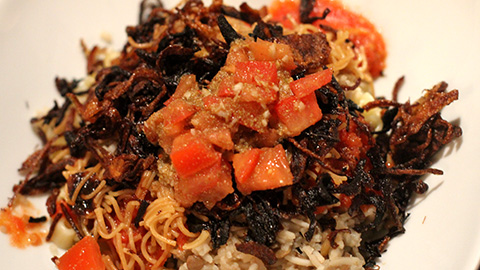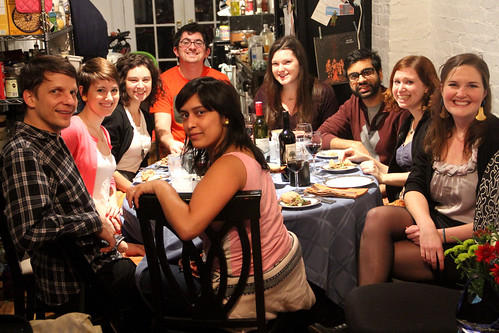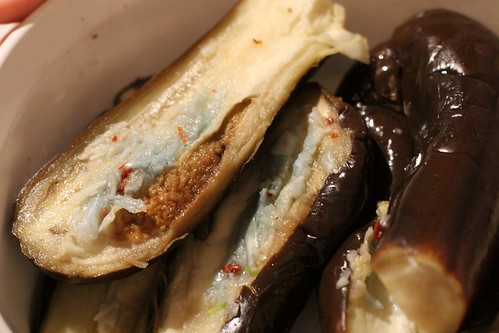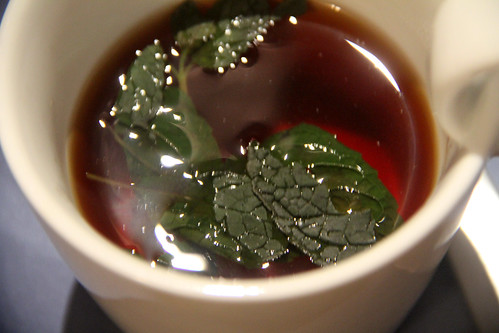 A friend who's been to Cuba suggested that "for many Cubans, food at the moment is state-issued ham sandwiches, which you could approximate with some layers of wet cardboard standing in for bread, and finely shaved erasers for the ham, all encased in a blister pack of clear cellophane." Our guest Tennessee reported that by far the most disgusting food she's had in her life was "street pizza" in Havana, during her time as a student there.
A friend who's been to Cuba suggested that "for many Cubans, food at the moment is state-issued ham sandwiches, which you could approximate with some layers of wet cardboard standing in for bread, and finely shaved erasers for the ham, all encased in a blister pack of clear cellophane." Our guest Tennessee reported that by far the most disgusting food she's had in her life was "street pizza" in Havana, during her time as a student there.
Fortunately, we were able to lean instead on the culinary traditions of families who've left Cuba. In fact, the structure of the meal was suggested by my colleague Wendy, who's from a Cuban family in South Florida. (Note the distinct lack of vegetables. Apparently this is very authentic.) Our guest Alex agreed that this food reminded him of what his Cuban mom makes.

Fortunately, we didn't have to contend with rationing, so this turned into quite the feast. The five mile bike ride back from the Food Bazaar supermarket was quite the haul, with a nine-pound pork shoulder and a three-liter jug of olive oil anchoring my saddlebags. Like I imagine many things in Cuba to be, the preparation was long and slow, folks trickled in as the smell of slowly barbecuing pork roasted through the house, and the payoff was lovely. Our guests were Sam, Beni, Nathalia, Ian, Alex, Tennessee, Kirsten, and Demián.
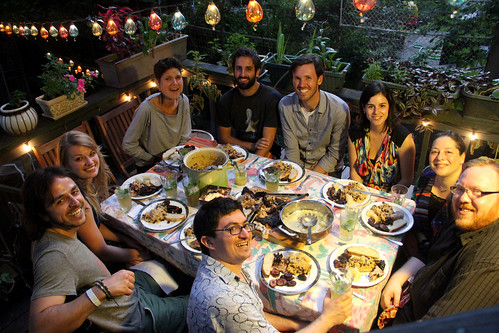
Cocteles | Cocktails | Recipes at bottom
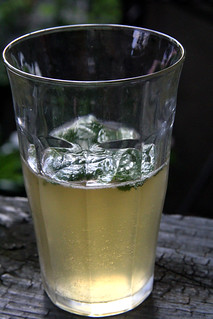
Sam was eager to mix some cocktails, and Laura and I were fully in support. As a major sugar producer for centuries, Cuba also developed a substantial rum industry. Pretty much everywhere besides the US they enjoy Havana Club and other Cuban rums; even Bacardi was based in Havana before they absconded with their yeast to escape nationalization and set up shop in Puerto Rico.
We started out with mojitos, of course, with fresh mint from the patio and a simple syrup made of demerara sugar. Now, I order mojitos frequently at bars, and it's fair to say I've had dozens if not hundreds in my life. This was one of the best. Not too minty, not too limey, and rather than being pure sweet, the richness of the demerara really held it together. Check out the recipe at the end.

The other drink Sam made was also rum-based, but in a very different direction. Made with orange liqueur, (homemade) grenadine, vermouth, and aged rum, it's called El Presidente, but I think of it as a Rumhattan. The vermouth balances the sweetness, and provided it's made from quality ingredients, which this sure was, it's a really complex drink worth lingering on.
Plátanos maduros | Fried sweet plantains | Recipe
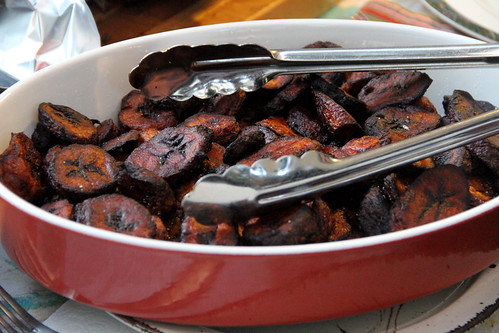
Baked plantains are definitely easier, faster for such a big crowd, healthier, and less labor intensive. But there's nothing like coins of super-ripe plantains shed of their nearly-black skin, cut on the bias, fried to within a minute of burning, and touched with a hint of salt. No matter how many of these I make, they always disappear.
Lechón asado | Roasted pork shoulder | Recipe

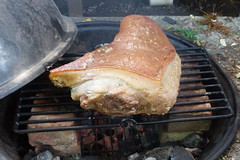

The planning for this dish started many months ago, when I wantonly suggested to a friend that I could build a pit in her backyard and roast a whole 80-pound pig in it. Among the many reasons this was a poor idea is that she's vegetarian! Anyway, I was happy to learn that you can do something similar with just part of a pig, hence the nine-pound shoulder. I hadn't once done a true charcoal this summer, and I'd be chagrined to miss this opportunity.
It started the night before with a mojo — not to be confused with mojito! — of sour orange juice, lots of olive oil, a smattering of onion, and 30(!) cloves of garlic. (Note that if you use fresh sour oranges for this recipe, it takes a lot of them! I got barely a cup from nine whole fruits, and filled the rest with lemon and lime juice.) I stabbed the shoulder with a knife a few hundred times, especially in the skin, to let the marinade in.
The next day, I built the coals, pushed them to the side, and let this beauty roast indirectly for six hours on low, slow heat. Interestingly it only took a few hours to reach safe-to-eat temperature, but two or three hours of extra cooking makes it so tender you can pull it with a fork. (One thing I'd do differently next time is to let the coals simmer down even more before putting the pork on. I think the outside seared too quickly and ended up closer to burnt than roasted.)
The pork turned out simply delicious; two days later we're still eating it for every meal, like a Thanksgiving turkey. It's a really cheap cut of meat (usually under $2/pound), and you can make it easily in the oven and not be fussy on the grill, so if you've got time and a crowd to feed, consider it!
Pan cubano | Cuban lard bread | Recipe

Would you guess that this bread is non-vegetarian? Well, the secret to its golden-brown hue and delightfully springy texture is none other than lard. What can I say, it's a really, really tasty loaf. The recipe is a little over the top in complaining about how long it takes; if you already make bread you'll know that two one-hour rises is pretty speedy actually. (I also have begun using diastatic malt powder in place of some of the sugar while proofing the yeast, and that speeds up the rise, improves the texture, and makes it last longer.)
I actually made two loaves; we used the second today to make a sandwich with some leftover pork. (And yes, we put pickles and other Cuban sandwich accoutrements on it.) Yum.
Moros y cristianos | Rice and beans | Recipe
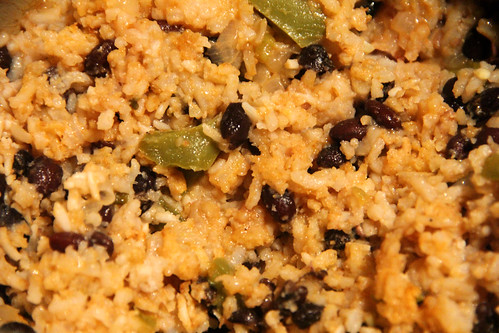
Cubans prepare rice and beans several different ways. Given my fondness for interesting food names, the choice was clear. Moros y cristianos means "Moors and Christians," a reference to the pairing of two different items on the same plate, just as two peoples shared the Iberian peninsula for centuries. Beyond the fun name, it's a super-tasty dish, with a onion-bell-pepper sofrito plus cumin providing that classic Latin rice smell and flavor. (Sometimes the dish is black, I think that's from saving the bean-cooking water for cooking the rice too.)
Yuca con ajo | Manioc with garlic sauce | Recipe

The same thing as manioc and cassava, which we've encountered many times. I think this is my favorite preparation of this starchy, bland root: covered in a sauce of olive oil, citrus and garlic!
Flan | Recipe

Tres leches refers to a dessert that has evaporated, condensed, and fresh milk. We made a tres leches rice pudding for Costa Rica, and a tres leches cake is to Latin America what tiramisú is to Italy: a baked good drenched in sweet liquid. Anyway, hold onto your arteries, because this flan is cuatro leches, courtesy of cream cheese! Probably non-traditional, but really, really tasty. As with the mojitos, the sugar in the caramel is demerara, which further enhances the rich, nutty flavor. And the flan itself was just great, perfectly set, not too sweet, just darn tasty.
It shouldn't surprise you that the Cuban music was top-notch, and thanks to our guests who'd been to Havana and beyond, we heard several stories of life in a country so close yet so far, such as the tradition of pouring a little splash on the ground from a newly-opened bottle for los santos.

Next, we're heading to the hills for the Labor Day weekend, where we'll do our Czech Republic meal!
Photos by Laura Hadden, whose love for Sam's mojitos knows no bounds.
~~~
Drinks (notes by Sam)
El Presidente:
1.5 oz. aged rum (I was using Bacardi 8)
3/4 oz. dry vermouth (I used Foro, which is Italian-produced and I don't think it's on the US market yet. Any French/dry vermouth would be good, and any blanc vermouth might be even better -- I hear Dolin blanc vermouth is fantastic in this drink)
1/4 oz. curacao (I used Clement Creole Shrubb, which is based on rhum agricole from Martinique, and has lots of vanilla and spicy notes to it. I bet the new Pierre Ferrand Dry Curacao would really work well here too.)
1/2 tsp. or dash grenadine (I used homemade grenadine, made of equal parts Pom Wonderful pomegranate juice and superfine sugar, shaken like hell till they combined.)
Stir with cracked ice and strain into a chilled cocktail glass, and garnish with an orange twist.
Mojito:
2 oz. silver rum (we used Don Q)
1 oz. lime juice (I actually just did the juice of half a lime for each drink, and was making two drinks at a time.)
3/4 oz. simple syrup (we used demerara sugar, of course, and I think that really made the difference. I also made it "rich simple syrup", with a 2:1 sugar:water ratio.
10 or so mint leaves
Seltzer water
RumDood has an extensive discussion of technique at the above link. I tend to depart a little bit from that, and I very gently muddled the mint in the bottom of each serving glass. (Too much, and it gets chalky or bitter.) I juiced half a lime into the shaker for each serving, added the rum and simple syrup, filled with ice, and shook like hell. Then strained that into the serving glasses, topped with soda (maybe two ounces, though it was inexact), and gave it a quick stir. (His dry-shake technique looks like one I'll have to try, though.)
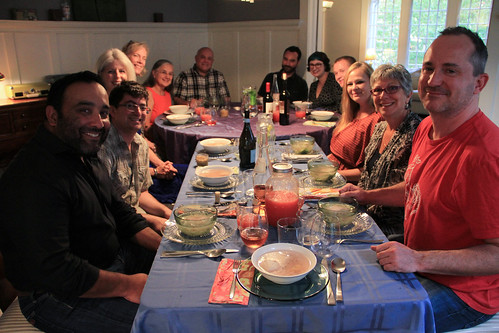
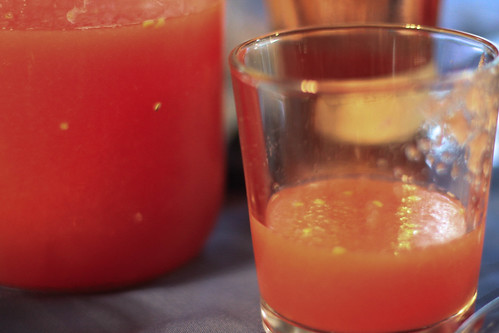
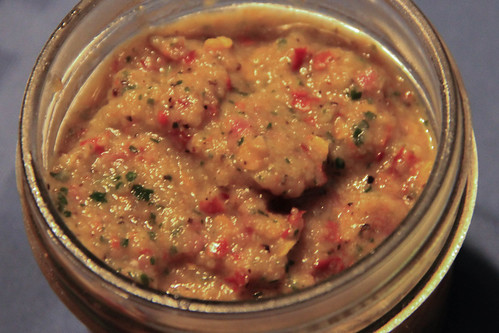

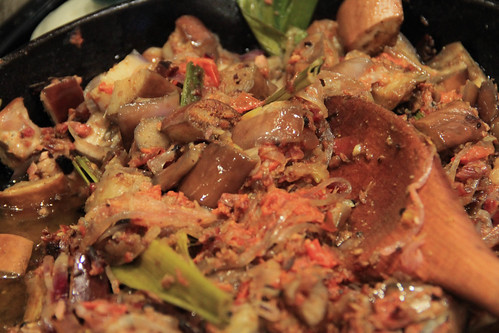
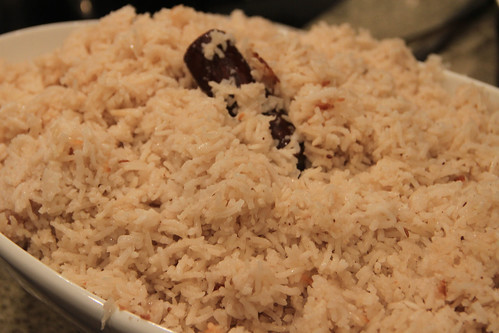
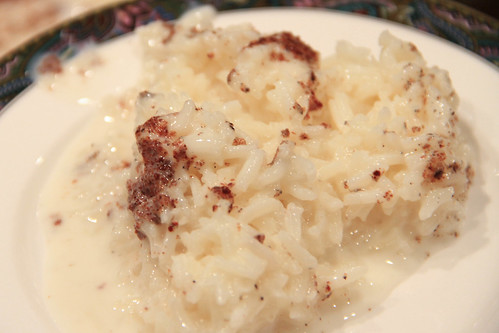
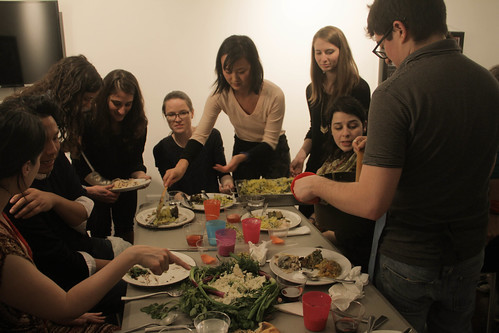

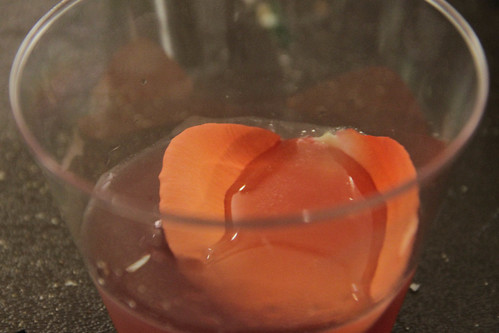
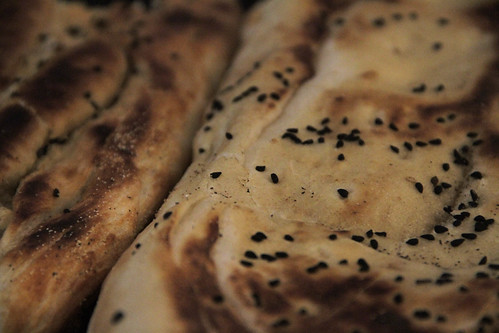


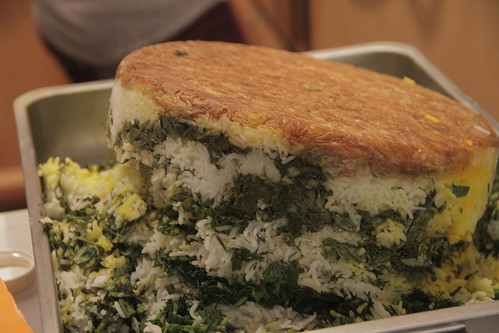
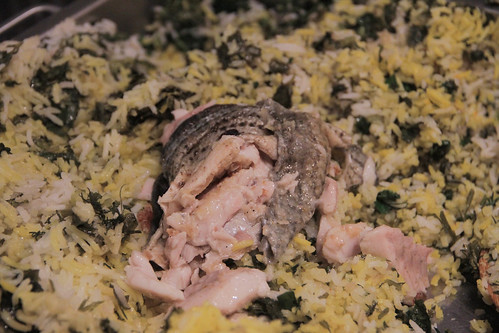
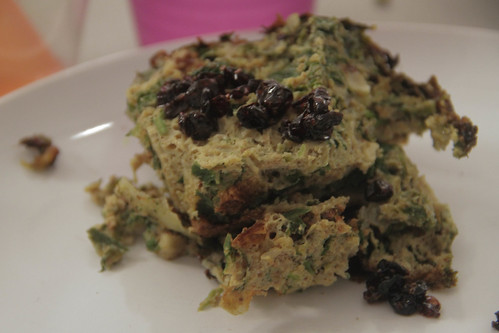
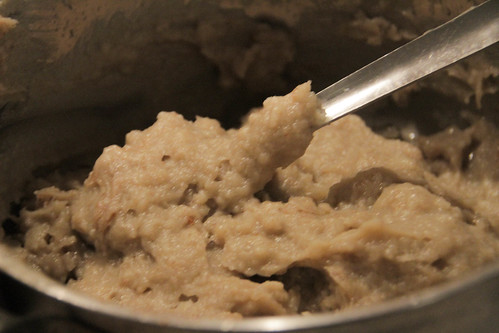
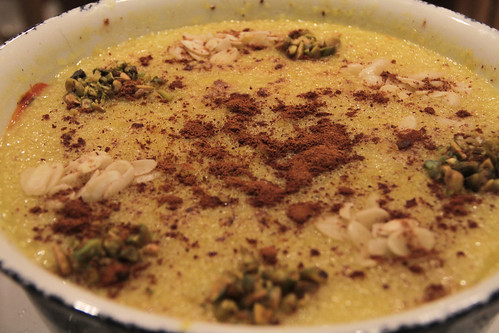
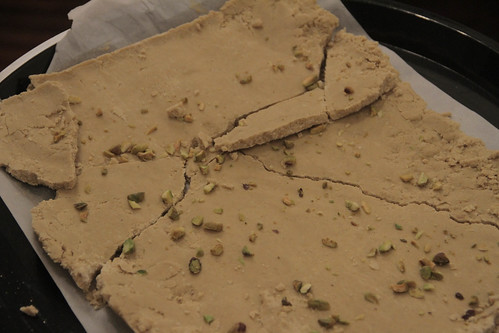



 At least in Guinea, fonio is eaten like couscous. It's a bit labor-intensive to cook; even the "pre-cooked" version first is plumped up with boiling water, steamed twice in cheesecloth, blended with a bit of okra powder to make it malleable (when you're eating with your hands it sure helps if it sticks together), and steamed once more. The texture was like couscous with a little more tooth, and it had a nice and mild nuttiness. If you happen to see fonio somewhere, give it a shot, before everyone discovers it in like ten years.
At least in Guinea, fonio is eaten like couscous. It's a bit labor-intensive to cook; even the "pre-cooked" version first is plumped up with boiling water, steamed twice in cheesecloth, blended with a bit of okra powder to make it malleable (when you're eating with your hands it sure helps if it sticks together), and steamed once more. The texture was like couscous with a little more tooth, and it had a nice and mild nuttiness. If you happen to see fonio somewhere, give it a shot, before everyone discovers it in like ten years.
